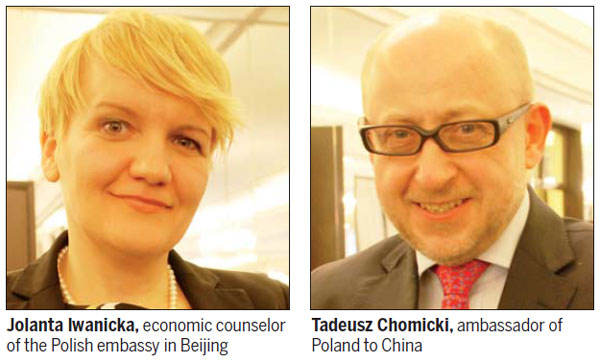Polish branding needs polish

| Models display amber jewelry by Polish designers. Poland has launched a series of events in China to raise the visibility of its products. Photos by Wang Chao / China Daily |
Poland is trying to fill information gap in minds of Chinese consumers
France equals perfumes and cosmetics, Germany equals technological know-how, Switzerland equals watches and Poland equals ... ?
The Polish government is trying to complete that equation and fill a huge information gap in the minds of Chinese business and consumers as it seeks more investment from the country.
One possible solution to the equation is amber, the fossilized tree resin famed for its beauty, and of which Poland is in abundant supply.
A recent fashion show in Beijing had amber accoutrements as its theme and featured clothing by two Polish designers, Maria Fudakowska and Yan Novac. The show was part of a program in China this year initiated by Poland's Ministry of Economy to promote its industries in China. The ministry reckons that Poland excels in luxury goods, biological industries and environmental protection.
"The promotion is more of a showcase of Polish design and culture," says Tadeusz Chomicki, ambassador of Poland to China. "We also have other activities such as seminars and conferences to introduce more business opportunities. Most Chinese do not associate luxury brands with Poland. Through these events we want to convey a message to Chinese consumers that we also have the capabilities to make top-class luxury goods."
Government figures from Poland show that about 900 factories make more than 22,000 yachts every year, 90 percent of which are exported. The yachts range from low-end to high-end, with the budget model priced at several thousand euros, and the luxury ones worth millions of euros. The major markets are Western Europe, Northern Europe and Mediterranean countries.
"In Monte Carlo or Miami, you can easily spot yachts made in Poland," Chomicki says.
Jolanta Iwanicka, economic counselor of the Polish embassy in Beijing, says Chinese consumers know much less about Poland compared with its Western European counterparts.
"For example, few people know that Poland is the sixth largest cosmetics manufacturer in Europe, and the products are sold to 160 countries."
Over the past 10 years, the value of Poland's cosmetics market has grown about 25 percent a year, she says, being worth about 3.4 billion euros in 2012. Hair and skincare products account for 35 percent of the market, followed by perfume, and men's skincare products and makeup.
China is Poland's biggest trading partner in Asia, and Poland is China's biggest trading partner in Central and Eastern Europe.
The Polish Ministry of Finance says trade between China and Poland tripled between 2005 and 2012, and amber accounts for a lot of that increase.
Polish amber, sometimes called "gold from the Baltic Sea", accounts for more than 70 percent of the amber sold in the world, and Poland estimates that more than 40 percent of these products are sold to Asia.
In Poland, 60 percent of the amber products are made by small and medium-sized businesses, and the number of people working in the industry in the country has grown from 500 in 1990 to more than 10,000 last year, Iwanicka says.
Pharmaceuticals is another fast-growing industry in Poland. Official figures show there are more than 140 pharmaceutical companies in the country and 111 institutes dedicated to research and development. Over the past eight years, exports of pharmaceutical products have risen about 30 percent a year, Iwanicka says.
The industry has become so prominent in Poland that pharmaceutical studies have become a highly popular subject choice among young Poles enrolling for university.
"We hope Chinese and Polish companies can form partnerships in jewelry, bio-technology, pharmaceuticals and cosmetics, machinery and food industries," says a statement from the Polish Ministry of Economy.
As the Chinese government calls for rejuvenation of the Silk Road, Iwanicka says this is a good opportunity for China and Poland to strengthen their business bonds.
"There is an overland Silk Road and there is a maritime one, and Poland lies on the continental road," she says. "I hope we can have better logistics along this road, so we can facilitate the imports and exports with China."
Poland would like to draw Chinese investors to work on railways, logistics centers and cargo stations in Poland to raise transport capacity between the two countries, she says.
The import-export ratio between Poland and China is 9:1, with Poland having a big trade deficit. Poland's imports are mostly textile products, and exports are copper, machinery, and bio-tech and environmental products, Iwanicka says.
By reviving the Silk Road, Poland hopes to increase the shipment of Polish products to China.
The majority of Poland's exports to China comprise machinery and equipment, 24 percent, motor vehicles, 14 percent, metals, 12 percent, plastics and rubber, 7 percent.
The Polish government is particularly interested in finding Chinese investors in sectors such as energy, jewelry, yachts and mining machinery.
In November, a subsidiary of China's State Grid signed a contract with a Polish counterpart to erect power lines and electricity substations. The contract is worth about 850 million yuan ($136 million; 99 million euros), and it is the first such deal between the two countries.
Chomicki says Poland has not had enough attention from Chinese investors. There are only a few projects from China reaching the level of $100 million, usually mergers and acquisitions.
"Chinese investors are either interested in the developed markets such as the UK and Germany, or less developed such as Africa. But I think Poland has a unique advantage.
"As a EU member, it has the transparency and equal opportunities; and compared with western European countries, our labor is about 50 percent cheaper."
Forming joint ventures may be ideal because Polish companies have the expertise to perform under EU conditions, and Chinese companies can bring their capital and technological know-how into the country, Chomicki says.
Chomicki, who was previously his country's ambassador to South Korea, says he introduced a TV set maker from that country to Poland when he was there, and now Poland is a major TV set exporter in Europe.
The South Korean electronics company Samsung has a research and development center in Poland that specializes in satellite-related technologies.
Poland has also had success in attracting investment in the aviation industry. It produces aviation parts and helicopters for German, US and Canadian companies.
"First they did manufacturing, but since last year, some companies have moved into engineering and design," Chomicki says.
There are 40 investment zones for foreign investors in Poland and 52 industrial parks for modern business.
Iwanicka says many Chinese investors are concerned about the difference in business mentality and the EU systems.
"Actually this can be an advantage for Chinese investors: everything is carried out under the EU framework, so it is transparent and regulated. This market is equal and welcomes open competition."
Contact the writers throughwangchao@chinadaily.com.cn

(China Daily European Weekly 05/16/2014 page20)
Today's Top News
- Tariff truce gains time for talks although some tough issues remain to be resolved: China Daily editorial
- China continues to suspend or removes export controls on some US entities
- Xi says China, Brazil can set example of unity, self-reliance in Global South
- China to extend tariff suspension on imported US products
- Joint Statement on China-US Economic and Trade Meeting in Stockholm
- More grads chart career paths in west of China






























